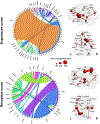Prediction of baseline expressive and receptive language function in children with focal epilepsy using diffusion tractography-based deep learning network
- PMID: 33740493
- PMCID: PMC8035310
- DOI: 10.1016/j.yebeh.2021.107909
Prediction of baseline expressive and receptive language function in children with focal epilepsy using diffusion tractography-based deep learning network
Abstract
Purpose: Focal epilepsy is a risk factor for language impairment in children. We investigated whether the current state-of-the-art deep learning network on diffusion tractography connectome can accurately predict expressive and receptive language scores of children with epilepsy.
Methods: We studied 37 children with a diagnosis of drug-resistant focal epilepsy (age: 11.8 ± 3.1 years) using 3 T MRI and diffusion tractography connectome: G = (S, Ω), where S is an adjacency matrix of edges representing the connectivity strength (number of white-matter tract streamlines) between each pair of brain regions, and Ω reflects a set of brain regions. A convolutional neural network (CNN) was trained to learn the nonlinear relationship between 'S (input)' and 'language score (output)'. Repeated hold-out validation was then employed to measure the Pearson correlation and mean absolute error (MAE) between CNN-predicted and actual language scores.
Results: We found that CNN-predicted and actual scores were significantly correlated (i.e., Pearson's R/p-value: 0.82/<0.001 and 0.75/<0.001), yielding MAE: 7.77 and 7.40 for expressive and receptive scores, respectively. Specifically, sparse connectivity not only within the left cortico-cortical network but also involving the right subcortical structures was predictive of language impairment of expressive or receptive domain. Subsequent subgroup analyses inferred that the effectiveness of diffusion tractography-based prediction of language outcome was independent of clinical variables. Intrinsic diffusion tractography connectome properties may be useful for predicting the severity of baseline language dysfunction and possibly provide a better understanding of the biological mechanisms of epilepsy-related language impairment in children.
Keywords: Deep learning network; Diffusion-weighted imaging (DWI) tractography; Language prediction; Pediatric epilepsy.
Copyright © 2021 Elsevier Inc. All rights reserved.
Conflict of interest statement
Declaration of competing interest
The authors declare no conflicts of interest in relation to this study.
Figures




Similar articles
-
Deep Learning-Based Tract Classification of Preoperative DWI Tractography Advances the Prediction of Short-Term Postoperative Language Improvement in Children With Drug-Resistant Epilepsy.IEEE Trans Biomed Eng. 2025 Feb;72(2):565-576. doi: 10.1109/TBME.2024.3463481. Epub 2025 Jan 21. IEEE Trans Biomed Eng. 2025. PMID: 39292577
-
Deep reasoning neural network analysis to predict language deficits from psychometry-driven DWI connectome of young children with persistent language concerns.Hum Brain Mapp. 2021 Jul;42(10):3326-3338. doi: 10.1002/hbm.25437. Epub 2021 May 5. Hum Brain Mapp. 2021. PMID: 33949048 Free PMC article.
-
Deep Relational Reasoning for the Prediction of Language Impairment and Postoperative Seizure Outcome Using Preoperative DWI Connectome Data of Children With Focal Epilepsy.IEEE Trans Med Imaging. 2021 Mar;40(3):793-804. doi: 10.1109/TMI.2020.3036933. Epub 2021 Mar 2. IEEE Trans Med Imaging. 2021. PMID: 33166251 Free PMC article.
-
Histological and MRI markers of white matter damage in focal epilepsy.Epilepsy Res. 2018 Feb;140:29-38. doi: 10.1016/j.eplepsyres.2017.11.010. Epub 2017 Nov 23. Epilepsy Res. 2018. PMID: 29227798 Review.
-
Potential and limitations of diffusion MRI tractography for the study of language.Brain Lang. 2014 Apr;131:65-73. doi: 10.1016/j.bandl.2013.06.007. Epub 2013 Jul 30. Brain Lang. 2014. PMID: 23910928 Review.
Cited by
-
Artificial intelligence in epilepsy - applications and pathways to the clinic.Nat Rev Neurol. 2024 Jun;20(6):319-336. doi: 10.1038/s41582-024-00965-9. Epub 2024 May 8. Nat Rev Neurol. 2024. PMID: 38720105 Review.
-
Deep Learning-Based Tract Classification of Preoperative DWI Tractography Advances the Prediction of Short-Term Postoperative Language Improvement in Children With Drug-Resistant Epilepsy.IEEE Trans Biomed Eng. 2025 Feb;72(2):565-576. doi: 10.1109/TBME.2024.3463481. Epub 2025 Jan 21. IEEE Trans Biomed Eng. 2025. PMID: 39292577
-
Artificial Intelligence in Epilepsy: A Systemic Review.J Epilepsy Res. 2025 Jun 10;15(1):2-22. doi: 10.14581/jer.25002. eCollection 2025 Jun. J Epilepsy Res. 2025. PMID: 40568057 Free PMC article. Review.
-
The Shape of the Brain's Connections Is Predictive of Cognitive Performance: An Explainable Machine Learning Study.Hum Brain Mapp. 2025 Apr 1;46(5):e70166. doi: 10.1002/hbm.70166. Hum Brain Mapp. 2025. PMID: 40143640 Free PMC article. Review.
-
TractGeoNet: A geometric deep learning framework for pointwise analysis of tract microstructure to predict language assessment performance.Med Image Anal. 2024 May;94:103120. doi: 10.1016/j.media.2024.103120. Epub 2024 Feb 23. Med Image Anal. 2024. PMID: 38458095 Free PMC article.
References
-
- Hermann BP, Bell B, Seidenberg M, Woodard A. Learning disabilities and language function in epilepsy. Epilepsia 2001;42:21–23. - PubMed
-
- Robinson RJ. The causes of language disorder: introduction and overview. In: Martin J, Fletcher P, Grunwell P, Hall D, editors. In: Proceedings of the first international symposium on specific speech and language disorders in children. Volume 29. London: Association for All Speech Impaired Children; 1987. p. 1–19.
-
- Robinson RJ. Causes and associations of severe and persistent specific speech and language disorders in children. Dev Med Child Neurol 1991;33:943–962. - PubMed
-
- Parkinson GM. High incidence of language disorder in children with focal epilepsies. Dev Med Child Neurol 2002;44:533–537. - PubMed
Publication types
MeSH terms
Grants and funding
LinkOut - more resources
Full Text Sources
Other Literature Sources

